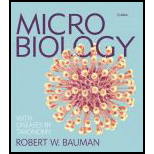
Concept explainers
Introduction:
Microbes are of two types: cellular and acellular. Acellular microbes are those microbes which contain some infectious agents like viruses and prions. Generally, acellular microbes do not have cells, for example, viruses, viroids and plasmids.
Answer to Problem 1MC
Correct answer:
Rickettsia is not an acellular agent; it is bacteria having cell wall. Therefore, option (c) is correct.
Option (c) is given as “rickettsia”,
Explanation of Solution
Justify reason for the correct statement:
Rickettsia is a gram negative, non spore forming and non motile bacteria. It found in the shape of cocci and rods. They have their own DNA and protein; they have their own metabolizing machinery. Acellular agents do not have their own DNA and they cannot
Hence, option (c) is correct.
Justify reasons for incorrect statements:
Option (a) is given as “viroid”.
Viroid is the smallest, single stranded, circular RNA infectious pathogen, it do not contain protein capsid. Viroids cause plant diseases. Viroid only contain RNA particle not other cells, so, they come under acellular agents. Hence, it is a wrong answer.
Option (b) is given as “virus”.
Virus is the small agents, made up of DNA or RNA and coated with protein coat. Viruses cause diseases, they are made up of only DNA, RNA or protein, and they do not contain any cell so they come under the acellular agents. Hence, it is a wrong answer.
Option (d) is given as “prion”.
Prions are the smallest organism, made up of protein and are the infectious agents. Prions mainly affect the brain. They do not have their own DNA and cannot metabolize, they are also acellular agents. Hence, it is a wrong answer.
Hence, options (a), (b) and (d) are incorrect.
Acellular microbes are those microbes which contain some infectious agents like viruses and prions. Generally acellular microbes do not have cells and DNA, for example, viruses, viroids and plasmids.
Want to see more full solutions like this?
Chapter 13 Solutions
Microbiology with Diseases by Taxonomy (5th Edition)
- Which of the following is antiviral drug? O a. Penicillin O b. Streptomycin O c. Acyclovir O d. Allarrow_forwardWhich of the following is an air-borne disease? A. Measles B. Typhoid C. Pink eye D. None of the abovearrow_forwardWhich of the following viruses can be oncogenic in humans?a. papillomavirus b. Epstein-Barr virus c. adenovirus d. both a and barrow_forward
- Which among the following is caused by a non enveloped viruses? a. Chicken pox b. mumps c. Influenza d. polioarrow_forwardThe coronavirus is named for it’s crown or “corona” in Latin which is made of A.jewels b.protein spikes c.ciliaarrow_forwardZoonotic viruses cause the same symptoms, with the same severity, in animals and in humans. A. True B. Falsearrow_forward
- Which of the following effects do antiviral drugs not have?a. destroying extracellular virusesb. stopping virus synthesisc. inhibiting virus maturationd. blocking virus receptorsarrow_forwardwhich of the following antibiotics is not bactericidal? a. vancomycin b.polymyxin b c. penicillin d. cephalosporins e. tetracyclinearrow_forwardWhich of the following is a commonality between coxsackievirus A16 infection and a varicella zoster infection?Choose one: A. Both infections are caused by viruses in the herpes family. B. Each disease is usually mild and self-limiting in children but is more severe in adults. C. Both viruses can cause a spotted rash to appear on the palms of the hands and soles of the feet. D. There is a vaccine available for both viruses.arrow_forward
- Why antibacterial drugs are ineffective against: A. Fungal Infections B. Viral infections C. Helminthic worm infectionsarrow_forwardWhich of the following vaccines is not administered by intramuscular injection? a. Measles vaccine b. DPT c. Tetanus toxoid d. Heap-B vaccinearrow_forwardThe varicella-zoster virus that causes chickenpox is classified as a.a. herpes virus b. pox virus c. papillomavirus d. parvovirusarrow_forward
 Medical Terminology for Health Professions, Spira...Health & NutritionISBN:9781305634350Author:Ann Ehrlich, Carol L. Schroeder, Laura Ehrlich, Katrina A. SchroederPublisher:Cengage Learning
Medical Terminology for Health Professions, Spira...Health & NutritionISBN:9781305634350Author:Ann Ehrlich, Carol L. Schroeder, Laura Ehrlich, Katrina A. SchroederPublisher:Cengage Learning
